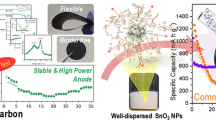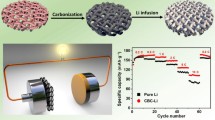Abstract
Orthorhombic Nb2O5-based nanoarchitectures have shown promise as electrode materials for Li-ion capacitors because they improve lithium ion transport and conductivity of Nb2O5 with high theoretical capacity. However, despite the several advantages of nanotubes, the facile synthesis of Nb2O5 nanotubes remains challenging. Herein, we present Nb2O5 nanotubes as an efficient ion- and electron-conducting electrode using environmentally friendly cellulose as sacrificial templates. The rational synthetic design based on sol–gel interactions with hydroxyl groups on the cellulosic surface enables uniformly covering the electrospun-cellulose one-dimensional templates with Nb2O5, resulting in unusual nanotubular Nb2O5 crystals featuring crystallographic iso-orientation owing to a controlled two-step calcination. Such crystallographically oriented nanotubes are favorable to fast Li+ intercalation kinetics for pseudocapacitive behavior with efficient lithium ion channels. The orthorhombic Nb2O5 nanotubes provide electrodes with a high initial capacity (163 mAh g−1), excellent rate capability (95 mAh g−1 at 5 A g−1), and stable cycle performance (81.8% retention after 1000 cycles at 5 A g−1) without any carbon composite and are thus superior to previously reported Nb2O5 electrodes. This simple strategy can open a new avenue for fabricating nanotubes of various transition metal oxides.
Graphic abstract









Similar content being viewed by others
References
Augustyn V, Come J, Lowe MA et al (2013) High-rate electrochemical energy storage through Li+ intercalation pseudocapacitance. Nat Mater 12:518–522
Baldinelli A, Dou X, Buchholz D et al (2018) Addressing the energy sustainability of biowaste-derived hard carbon materials for battery electrodes. Green Chem 20:1527
Boury B, Plumejeau S (2015) Metal oxides and polysaccharides: an efficient hybrid association for materials chemistry. Green Chem 17:72–88
Brezesinski K, Wang J, Haetge J et al (2010a) Pseudocapacitive contributions to charge storage in highly ordered mesoporous group V transition metal oxides with iso-oriented layered nanocrystalline domains. J Am Chem Soc 132:6982–6990
Brezesinski T, Wang J, Tolbert SH et al (2010b) Ordered mesoporous alpha-MoO3 with iso-oriented nanocrystalline walls for thin-film pseudocapacitors. Nat Mater 9:146–151
Chen WJ, Sun X, Liu Y et al (2020) Nb2O5 Nanorod bundles for photocatalytic ethylene oxidation. ACS Appl Nano Mater 3:2573–2581
Cheong JY, Jung JW, Youn DY et al (2017) Mesoporous orthorhombic Nb2O5 nanofibers as pseudocapacitive electrodes with ultra-stable Li storage characteristics. J Power Sources 360:434–442
Come J, Augustyn V, Kim JW et al (2014) Electrochemical kinetics of nanostructured Nb2O5 electrodes. J Electrochem Soc 161:A718–A725
Conway BE (1991) Transition from “supercapacitor” to “battery” behavior in electrochemical energy storage. J Electrochem Soc 138:1539
Conway BE (2013) Electrochemical supercapacitors: scientific fundamentals and technological applications. Springer, Berlin, p 2013
Deng B, Lei T, Zhu W et al (2018) In-plane assembled orthorhombic Nb2O5 nanorod films with high-rate Li+ intercalation for high-performance flexible Li-ion capacitors. Adv Funct Mater 28:1704330
Falk G, Borlaf M, López-Muñoz MJ et al (2017) Microwave-assisted synthesis of Nb2O5 for photocatalytic application of nanopowders and thin films. J Mater Res 32:3271–3278
Galstyan V, Comini E, Faglia G et al (2014) Synthesis of self-ordered and well-aligned Nb2O5 nanotubes. CrystEngComm 16:10273–10279
Greczynski G, Hultman L (2017) C 1s peak of adventitious carbon aligns to the vacuum level: Dire consequences for material's bonding assignment by photoelectron spectroscopy. ChemPhysChem 18:1507–1512
Grote F, Kühnel RS, Balducci A et al (2014) Template assisted fabrication of free-standing MnO2 nanotube and nanowire arrays and their application in supercapacitors. Appl Phys Lett 104:053904–53911
Gupta A, Mittal M, Singh MK et al (2018) Low temperature synthesis of NbC/C nano-composites as visible light photoactive catalyst. Sci Rep 8:13597
Han J, Liu Z, Ma Y et al (2018) Ambient N2 fixation to NH3 at ambient conditions: using Nb2O5 nanofiber as a high-performance electrocatalyst. Nano Energy 52:264–270
Hu CC, Chang KH, Lin MC et al (2006) Design and tailoring of the nanotubular arrayed architecture of hydrous RuO2 for next generation supercapacitors. Nano Lett 6:2690–2695
Huang J, Kunitake T (2003) Nano-precision replication of natural cellulosic substances by metal oxides. J Am Chem Soc 125:11834–11835
Huang J, Matsunaga N, Shimanoe K et al (2005) Nanotubular SnO2 templated by cellulose fibers: synthesis and gas sensing. Chem Mater 17:3513–3518
Ichinose I, Senzu H, Kunitake T (1997) A surface sol−gel process of TiO2 and other metal oxide films with molecular precision. Chem Mater 9:1296–1298
Jiang Y, Liu J (2019) Definitions of pseudocapacitive materials: a brief review. Energy Environ Mater 2(1):30–37
Kim JW, Augustyn V, Dunn B (2012) The effect of crystallinity on the rapid pseudocapacitive response of Nb2O5. Adv Energy Mater 2:141–148
Kong L, Cao X, Wang J et al (2016) Revisiting Li+ intercalation into various crystalline phases of Nb2O5 anchored on graphene sheets as pseudocapacitive electrodes. J Power Sources 309:42–49
Kötz R, Carlen M (2000) Principles and applications of electrochemical capacitors. Electrochim Acta 45:2483–2498
Lai CH, Ashby D, Moz M et al (2017) Designing pseudocapacitance for Nb2O5/Carbide-derived carbon electrodes and hybrid devices. Langmuir 33:9407–9415
Li S, Huang J (2016) Cellulose-rich nanofiber-based functional nanoarchitectures. Adv Mater 28:1143–1158
Li S, Wang T, Zhu W et al (2019a) Controllable synthesis of uniform mesoporous H-Nb2O5/rGO nanocomposites for advanced lithium ion hybrid supercapacitors. J Mater Chem A7:693–703
Li Y, Wang H, Wang L et al (2019b) Mesopore-induced ultrafast Na+-storage in T-Nb2O5/Carbon nanofiber films toward flexible high-power Na-ion capacitors. Small 15:1804539
Liu X, Gu Y, Huang J (2010) Hierarchical, titania-coated, carbon nanofibrous material derived from a natural cellulosic substance. Chemistry 16:7730–7740
Liu CP, Zhou F, Ozolins V (2012) First principles study for lithium intercalation and diffusion behavior in orthorhombic Nb2O5 electrochemical supercapacitor. Bull Am Phys Soc B 26:003
Liu M, Yan C, Zhang Y (2015) Fabrication of Nb2O5 nanosheets for high-rate lithium ion storage applications. Sci Rep 5:8326
Liu Y, Zhang N, Yu C et al (2016) MnFe2O4@C nanofibers as high-performance anode for sodium-ion batteries. Nano Lett 16:3321–3328
Liu X, Liu G, Chen H et al (2017) Facile synthesis of Nb2O5 nanobelts assembled from nanorods and their applications in lithium ion batteries. J Phys Chem Solids 111:8–11
Lou L, Kong X, Zhu T et al (2019) Facile fabrication of interconnected-mesoporous T-Nb2O5 nanofibers as anodes for lithium-ion batteries. Sci China Mater 62:465–473
Lv Y, Wu Z, Qian X et al (2013) Site-specific carbon deposition for hierarchically ordered core/shell-structured graphitic carbon with remarkable electrochemical performance. Chemsuschem 6:1938–1944
Ma X, Chen Y, Li H et al (2015) Annealing-free synthesis of carbonaceous Nb2O5 microspheres by flame thermal method and enhanced photocatalytic activity for hydrogen evolution. Mater Res Bull 66:51–58
Ma D, Li Y, Zhang P et al (2016) Mesoporous Li1.2Mn0.54Ni0.13Co0.13O2 nanotubes for high-performance cathodes in Li-ion batteries. J Power Sources 311:35–41
McCafferty E, Wightman JP (1998) Determination of the concentration of surface hydroxyl groups on metal oxide films by a quantitative XPS method. Suf Interface Anal 26:549–564
Mehrotra R (1986) Reactions and synthetic applications of metal alkoxides. Proc Indian Natn Sci Acad 52A(4):954–972
Oh SI, Kim JC, Dar MA et al (2019) Synthesis and characterization of uniform hollow TiO2 nanofibers using electrospun fibrous cellulosic templates for lithium-ion battery electrodes. J Alloys Compd 800:483–489
Panda PK, Grigoriev A, Mishra YK et al (2020) Progress in supercapacitors: roles of two dimensional nanotubular materials. Nanoscale Adv 2(1):70–108
Park S, Lee S, Seo SW et al (2013) Tailoring nanobranches in three-dimensional hierarchical rutile heterostructures: a case study of TiO2–SnO2. CrystEngComm 15:2939–2948
Peng L, Xiong P, Ma L et al (2017) Holey two-dimensional transition metal oxide nanosheets for efficient energy storage. Nat Commun 8:15139
Poletto M, Dettenborn J, Pistor V et al (2010) Materials produced from plant biomass. Part I: evaluation of thermal stability and pyrolysis of wood. Mater Res 13:375–379
Poletto M, Pistor V, Santana RMC et al (2012) Materials produced from plant biomass. Part II: evaluation of crystallinity and degradation kinetics of cellulose. Mater Res 15:421–427
Schubert U (2004) Sol–gel processing of metal compounds. ChemInform. https://doi.org/10.1002/chin.200447271
Sun Z, Kim JH, Liao T et al (2012) Continually adjustable oriented 1D TiO2 nanostructure arrays with controlled growth of morphology and their application in dye-sensitized solar cells. CrystEngComm 14:5472–5478
Venkataramanan NS, Matsui K, Kawanami H et al (2007) Green synthesis of titania nanowire composites on natural cellulose fibers. Green Chem 9:18–19
Wang Y, Wen X, Chen J et al (2015) Foamed mesoporous carbon/silicon composite nanofiber anode for lithium ion batteries. J Power Sources 281:285–292
Wang Y, Song Y, Xia Y (2016) Electrochemical capacitors: mechanism, materials, systems, characterization and applications. Chem Soc Rev 45:5925–5950
Wei M, Wei K, Ichihara M et al (2008) Nb2O5 nanobelts: a lithium intercalation host with large capacity and high rate capability. Electrochem Commun 10:980–983
Wu X, Zeng Y, Gao H et al (2013) Template synthesis of hollow fusiform RuO2·xH2O nanostructure and its supercapacitor performance. J Mater Chem A 1:469–472
Xia C, Alshareef HN (2015) Self-templating scheme for the synthesis of nanostructured transition-metal chalcogenide electrodes for capacitive energy storage. Chem Mater 27:4661–4668
Xia H, Feng J, Wang H et al (2010) MnO2 nanotube and nanowire arrays by electrochemical deposition for supercapacitors. J Power Sources 195:4410–4413
Xiong D, Li X, Bai Z et al (2018) Recent advances in layered Ti3C2Tx MXene for electrochemical energy storage. Small 14:e1703419
Xue L, Fu K, Li Y et al (2013) Si/C composite nanofibers with stable electric conductive network for use as durable lithium-ion battery anode. Nano Energy 2:361–367
Yang H, Yan R, Chen H et al (2006) In-depth investigation of biomass pyrolysis based on three major components: Hemicellulose, cellulose, and lignin. Energ Fuel 20:388–393
Yu Q, Wu P, Xu P et al (2008) Synthesis of cellulose/titanium dioxide hybrids in supercritical carbon dioxide. Green Chem 10:1061–1067
Zeng J, Li R, Liu S et al (2011) Fiber-like TiO2 nanomaterials with different crystallinity phases fabricated via a green pathway. ACS Appl Mater Interfaces 3:2074–2079
Zhang J, Ma J, Zhang LL et al (2010) Template synthesis of tubular ruthenium oxides for supercapacitor applications. J Phys Chem C 114:13608–13613
Zheng S, Li X, Yan B et al (2017) Transition-metal (Fe Co, Ni) based metal-organic frameworks for electrochemical energy storage. Adv Energy Mater 7:1602733
Zhi X, Liang G, Wang L et al (2010) Optimization of carbon coatings on LiFePO4: carbonization temperature and carbon content. J Alloys Compd 503:370–374
Acknowledgments
This work was supported by the National Research Foundation of Korea (NRF) Grant funded by the Ministry of Science and ICT (2019R1A2B5B02070203) and by a Korea University Grant.
Author information
Authors and Affiliations
Corresponding authors
Additional information
Publisher's Note
Springer Nature remains neutral with regard to jurisdictional claims in published maps and institutional affiliations.
Electronic supplementary material
Below is the link to the electronic supplementary material.
Rights and permissions
About this article
Cite this article
Park, J.C., Park, S. & Kim, DW. High-power lithium-ion capacitor using orthorhombic Nb2O5 nanotubes enabled by cellulose-based electrospun scaffolds. Cellulose 27, 9991–10006 (2020). https://doi.org/10.1007/s10570-020-03468-0
Received:
Accepted:
Published:
Issue Date:
DOI: https://doi.org/10.1007/s10570-020-03468-0




